And now that Christmas approaches...
Nombre total de pages vues
24/12/2018
23/12/2018
Photographie - Un incroyable lac glacé photographié sur Mars

Ce lac glacé, situé dans un cratère de 82 kilomètres de large, a été immortalisé par la sonde Mars Express.
Une immense étendue blanche perdue au milieu d'un désert de roches rouges. C'est le spectacle fascinant photographié par la sonde Mars Express, en orbite depuis 2003, et partagé sur les réseaux sociaux par l'Agence spatiale européenne vendredi.
Cette patinoire géante se trouve dans le cratère de Korolev, large de 82 kilomètres et profond de deux kilomètres, dans les basses terres de l'hémisphère nord martien, près de la calotte polaire.
Un "piège froid"
Au centre du cratère, l'épaisseur de glace, quelle que soit la période de l'année, atteint 1,8 kilomètre, explique l'Agence spatiale européenne sur son site. Un phénomène appelé "piège froid" se produit : l'air, refroidi par la glace, s'affaisse et crée un bouclier thermique. "L'air est un mauvais conducteur de chaleur, ce qui exacerbe cet effet et maintient le cratère de Korolev gelé en permanence", écrit l'ESA.
L'Express - France
Astronomy picture of the day - 2018 December 23 - Earthrise: A Video Reconstruction
Explanation: About 12 seconds into this video, something unusual happens. The Earth begins to rise. Never seen by humans before, the rise of the Earth over the limb of the Moon occurred 50 years ago tomorrow and surprised and amazed the crew of Apollo 8. The crew immediately scrambled to take still images of the stunning vista caused by Apollo 8's orbit around the Moon. The featured video is a modern reconstruction of the event as it would have looked were it recorded with a modern movie camera. The colorful orb of our Earth stood out as a familiar icon rising above a distant and unfamiliar moonscape, the whole scene the conceptual reverse of a more familiar moonrise as seen from Earth. To many, the scene also spoke about the unity of humanity: that big blue marble -- that's us -- we all live there. The two-minute video is not time-lapse -- this is the real speed of the Earth rising through the windows of Apollo 8. Seven months and three missions later, Apollo 11 astronauts would not only circle Earth's moon, but land on it.
22/12/2018
Astronomy picture of the day - 2018 December 22 - A Cold December Night
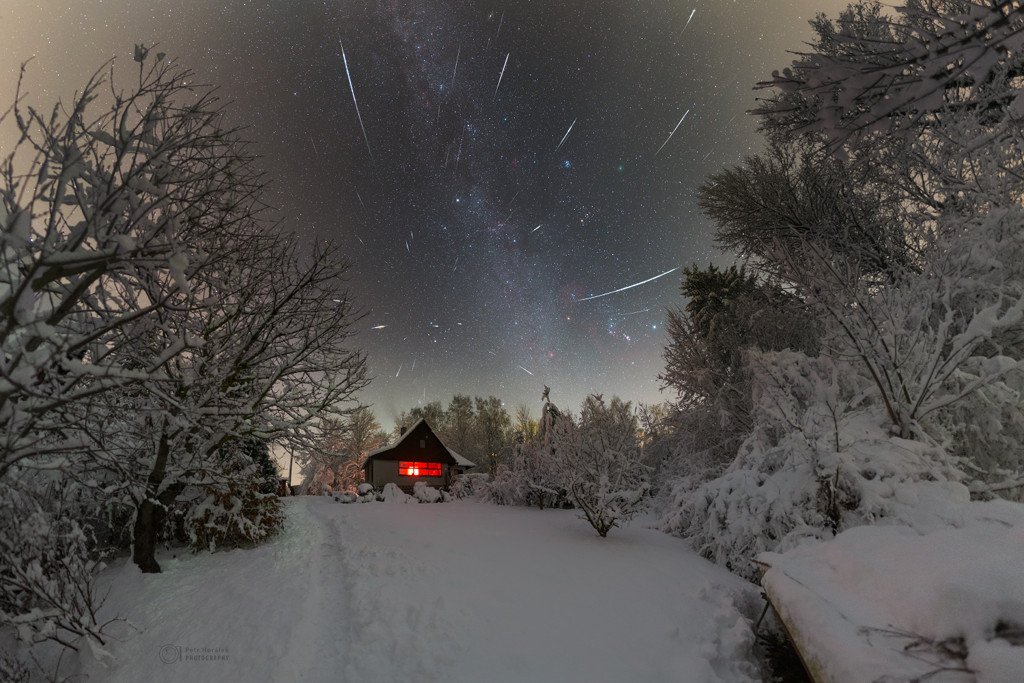
Image Credit & Copyright: Petr Horálek
Explanation: They say Orion always comes up sideways, and he does seem to on this cold December night. The bright stars of the familiar northern winter constellation lie just above the snowy tree tops surrounding a cozy cottage near the town of Ustupky in the Czech Republic. But Gemini's meteors also seem to rain on the wintry landscape. The meteor streaks are captured in exposures made near last Friday's peak of the annual Geminid meteor shower. They stream away from the shower's radiant above the trees, near the two bright stars of the zodiacal constellation of the Twins. Comet Wirtanen, a visitor to planet Earth's skies, is visible too. Look for its telltale greenish coma near the starsof the seven sisters.
21/12/2018
Extraordinary Solar Halos - Astronomy picture of the day - 2018 December 21
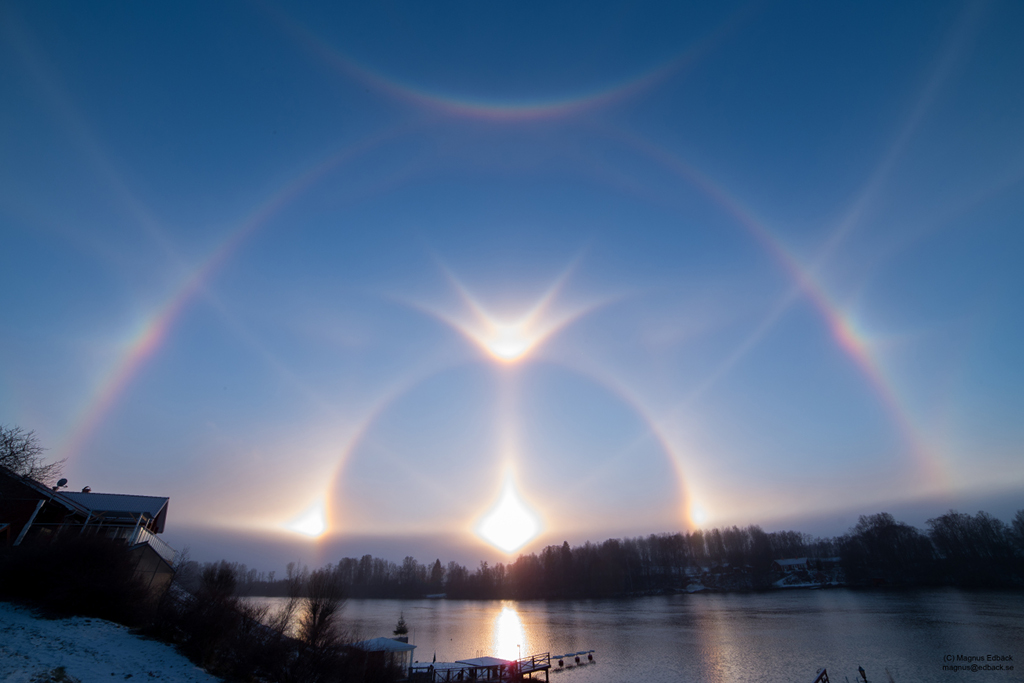
Explanation: Welcome to the December Solstice, the first day of winter in planet Earth's northern hemisphere and summer in the south. To celebrate, consider this extraordinary display of beautiful solar ice halos! More common than rainbows, simple ice halos can be easy to spot, especially if you can shade your eyes from direct sunlight. Still it's extremely rare to see anything close to the complex of halos present in this astounding scene. Captured at lunchtime on a cold December 14 near Utendal, Sweden the image includes the relatively ordinary 22 degree halo, sundogs (parhelia) and sun pillars. The extensive array of rarer halos has been identified along with previously unknown features. All the patterns are generated as sunlight (or moonlight) is reflected and refracted in flat six-sided water ice crystals in Earth's atmosphere. In this case, likely local contributors to the atmospheric ice crystals are snow making machines operating at at nearby ski center.
20/12/2018
Red Nebula, Green Comet, Blue Stars - Astronomy picture of the day - 2018 December 20
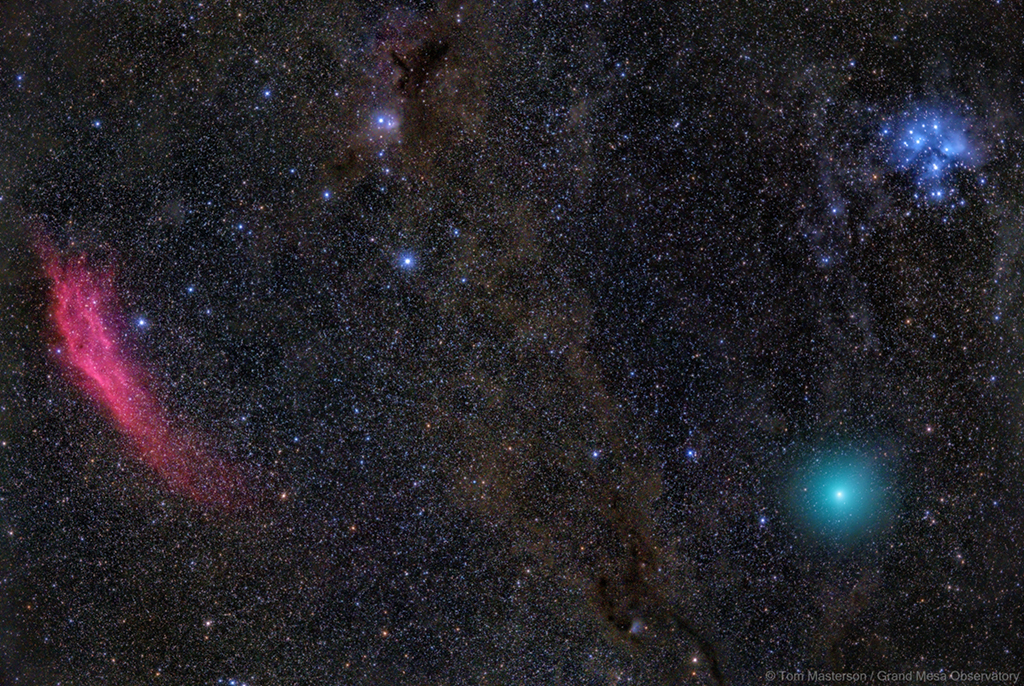
Explanation: This festively colored skyscape was captured in the early morning hours of December 17, following Comet Wirtanen's closest approach to planet Earth. The comet was just visible to the eye. The lovely green color of its fluorescing cometary atmosphere or coma is brought out here only by adding digital exposures registered on the comet's position below the Pleiades star cluster. The exposures also bring out blue starlight reflected by the dust clouds surrounding the young Pleiades stars. Gaze (toward the left) across dusty dark nebulae along the edge of the Perseus molecular cloud and you'll travel to emission nebula NGC 1499, also known as the California nebula. Too faint for the eye, the cosmic cloud's pronounced reddish glow is from electrons recombining with ionized hydrogen atoms. Around December 23rd, Comet Wirtanen should be easy to find with binoculars when it sweeps close to bright star Capella in the northern winter constellation Auriga, the Charioteer.
19/12/2018
A Rainbow Geminid Meteor - Astronomy picture of the day - 2018 December 19
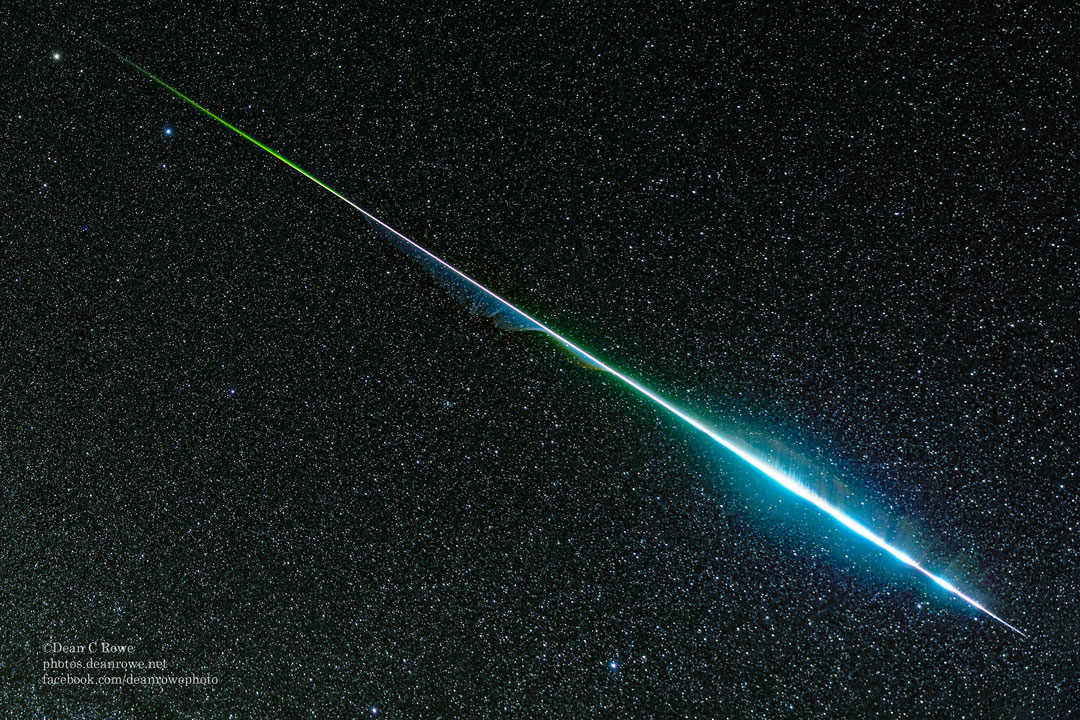
Explanation: Meteors can be colorful. While the human eye usually cannot discern many colors, cameras often can. Pictured is a Geminid captured by camera during last week's meteor shower that was not only impressively bright, but colorful. The radiant grit cast off by asteroid 3200 Phaethon blazed a path across Earth's atmosphere longer than 60 times the angular diameter of the Moon. Colors in meteors usually originate from ionized elements released as themeteor disintegrates, with blue-green typically originating from magnesium, calcium radiating violet, and nickel glowing green. Red, however, typically originates from energized nitrogen and oxygen in the Earth's atmosphere. This brightmeteoric fireball was gone in a flash -- less than a second -- but it left a wind-blown ionization trail that remained visible for several minutes, the start of which can be seen here.
Methane Bubbles Frozen in Lake Baikal - Astronomy picture of the day - 2018 December 18
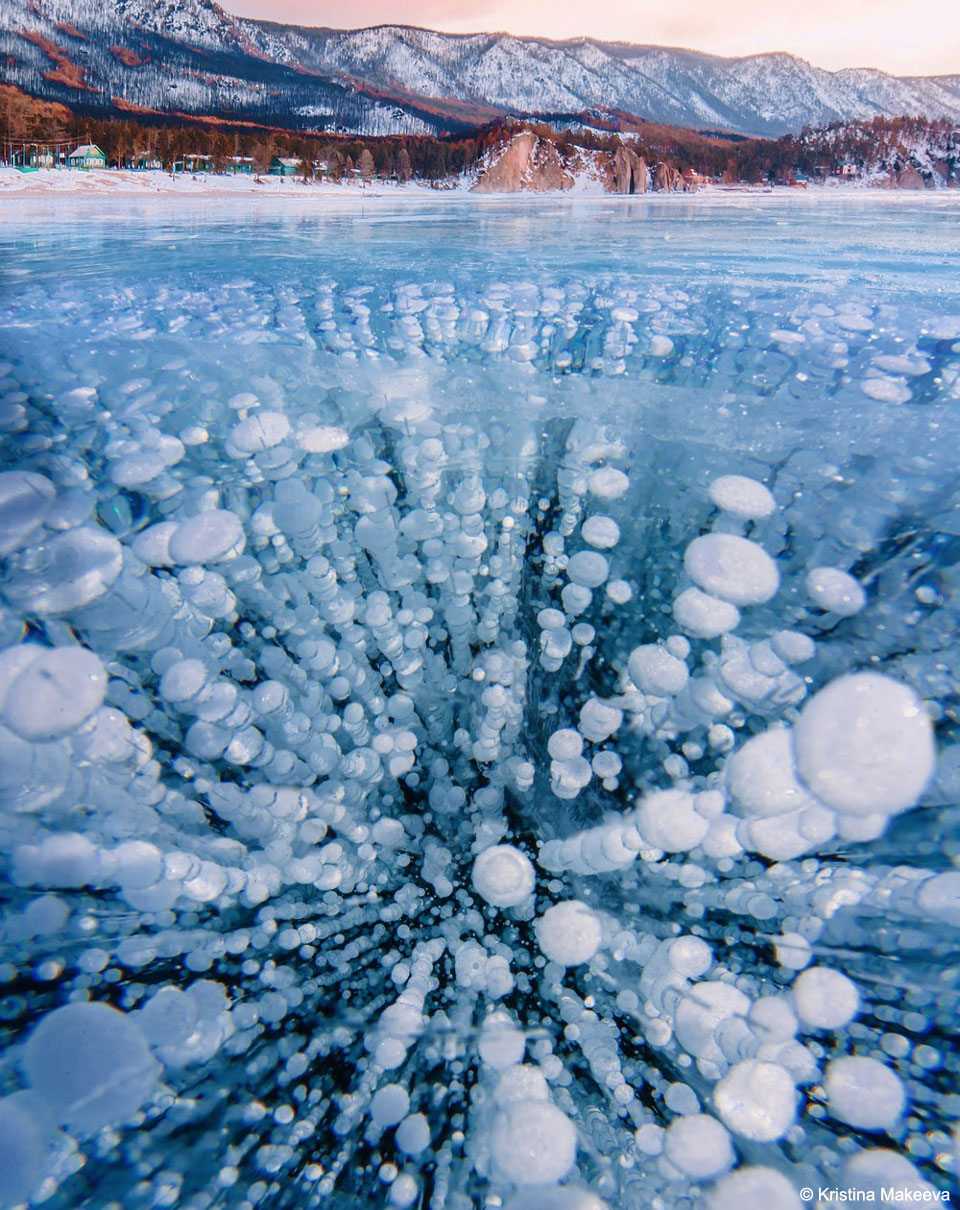
Explanation: What are these bubbles frozen into Lake Baikal? Methane. Lake Baikal, a UNESCO World Heritage Site in Russia, is the world's largest (by volume), oldest, and deepest lake, containing over 20% of the world's fresh water. The lake is also a vast storehouse of methane, a greenhouse gas that, if released, could potentially increase the amount of infrared light absorbed by Earth's atmosphere, and so increase the average temperature of the entire planet. Fortunately, the amount of methane currently bubbling out is not climatologically important. It is not clear what would happen, though, were temperatures to significantly increase in the region, or if the water level in Lake Baikalwere to drop. Pictured, bubbles of rising methane froze during winter into the exceptionally clear ice covering the lake.
18/12/2018
Inscription à :
Commentaires (Atom)
ASTRONOMY - Orion and the Ocean of Storms
2025 December 13 Orion and the Ocean of Storms Image Credit: NASA , Artemis 1 Explanation: On December 5, 2022, a camera on board the u...

-
2022 September 26 All the Water on Planet Earth Illustration Credit: Jack Cook, Adam Nieman, Woods Hole Oceanographic Institution ; Data ...
-
2025 May 11 The Surface of Venus from Venera 14 Image Credit: Soviet Planetary Exploration Program , Venera 14 ; Processing & Copyri...
